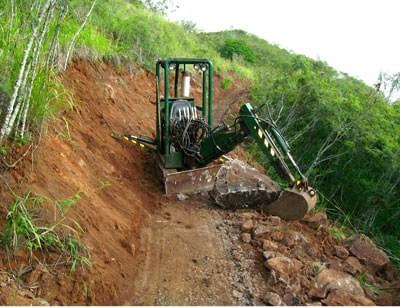





This award recognizes a trail-related product, process, or service that has significantly met a need, addressed an issue, or increased efficiency in trail design, development, or maintenance.

Improvements to trail building machines enable efficient trail construction in steep environments
Gerry Wilbour has served as President of the Professional Trailbuilders Association for several years and has come to be admired as a forthright and effective leader in the trail contractors' industry, as well as a technical innovator always on the cutting edge of design and construction solutions.
Trailbuilding occurs often in remote locations and calls for unique methods and skills, an ability to see what the land requires to achieve a final trail project that holds up long term. Where needed, good contractors like Gerry know when to call upon outside resources and bring in talented experts so that he can meet and actually exceed the requirements of government agencies and clients.
Below are provided some of his unique contributions to the trail building profession, including extensive, brilliant modifications to the first machine designed specifically for building trails, his own bridge fabrication system and use of helicopters for remote installations, and any number of creative, effective solutions for building trails.
Past and Ongoing State of the Art Innovations:
Custom "Trail Cat" - While initially based on the design of the Morison Trail Blazer, it is heavily modified to provide greater power, bucket capacity and reach, better role and stability protection for safety and efficiency in challenging environments. It has a winch anywhere capability and has digging power and strength of a much larger machine yet works efficiently on 30” trail in steep environments. The modifications have been ongoing since 1984. It is used where conventional mini excavators can’t go or are too unsafe. It has made machine construction possible for numerous customers and clients thereby lowering project cost (sometimes dramatically), and improving project quality.
Pioneered concrete work on structures in remote environments and gravel surfacing and hardening of trails by helicopters. Developed cost effective and helicopter friendly trail bridge designs. Innovations lead to higher quality, more sustainable trails and structures.
Developed efficient and effective construction methods for low impact graveling and paving trail. Innovations lead to creating higher quality, more sustainable barrier free trail opportunities in remote and unique environments.
Applied modern geotechnical engineering solutions to trails in challenging environments. These projects have included boardwalks and overlooks in peat bogs on pipe pile, anchoring boardwalks in areas subject to flooding, cribbing, retaining walls and stairs on steep slopes with a recent history of failure. Two recent sample projects include the Grey Wolf Trail in the Buckhorn Wilderness of the Olympic Mountains. A native log cribbing was anchored to competent bedrock on either side of a crumbling bedrock seam. Work required being suspended by climbing on rope.
The current project involves a trail connection through an extremely steep gulch area in Mukilteo, Washington. Steep failing fine grain dirt slopes have, up to now made a formal trail connection impossible through the lower gulch. Conventional timber or rock cribbing would not have provided sufficient anchoring into the slope and likely would have made matter worse by creating an additional load on an already unstable slope.
Much deeper anchoring into the slope, common to modern geotechnical solutions was necessary to create a sustainable trail route with minimal impact on the slope. This was very much a collaborative effort. In addition to Northwest Trails contribution to preliminary design and final layout and construction, credit is due to the City Engineering Staff, Camp Fuller for the Civil Engineering and to Terracon Consulting Engineers for Geotechnical Engineering Review and Input. Anchoring to the slope included two rows of linked pipe pile with a maximum 18‘ length, and “Manta Ray” tipping plate style tie back anchors into the backslope as a horizontal anchor. Much of the work was accomplished from climbing ropes and with a winch and rigging suspending a pneumatic pipe driver and 90 pound jack hammer.
Treated timbers were used across the face of the wall to retain the backfill and tie the structures together in a cohesive whole and for retaining and anchoring against the backwall. The structure was backfilled with geofoam for it’s cohesiveness and extreme light weight and pea gravel to fill voids and provide drainage. Additional shorter pin pile walls are being built to support the trail and it’s backslope to minimized its impact on slopes up to 120%.
2015: Single Track, LLC
2010: City of San Jose, Department of Parks, Recreation & Neighborhood Services
2008: Chris McNeil
2006: Cedar Valley Trails 911 Signs Project, Iowa
2004: City of Austin
677 views • posted 01/29/2018